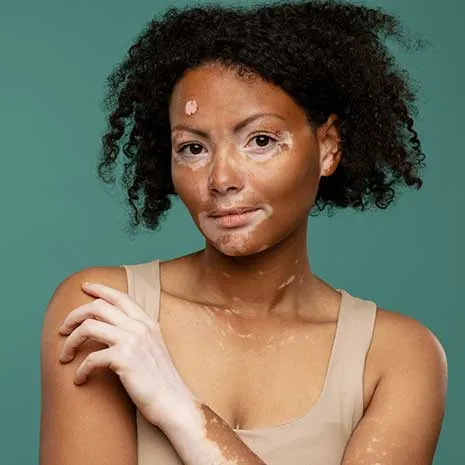The Role of Pigment Cells in Vitiligo: How Melanocytes Are Affected

The Role of Pigment Cells in Vitiligo: How Melanocytes Are Affected
- 17 August 2025
- 107

What Are Melanocytes and Why Are They Important?
Melanocytes are specialized cells located in the basal layer of the epidermis and in hair follicles. Their primary role is to produce melanin, the pigment responsible for skin, hair, and eye color.
Besides determining color, melanin also provides photoprotection by absorbing harmful ultraviolet (UV) radiation, thereby protecting skin cells from DNA damage.
How Are Pigment Cells Affected in Vitiligo?
Vitiligo is characterized by the selective loss of melanocytes, resulting in depigmented (white) patches on the skin. The primary cause is autoimmunity: the body’s immune system mistakenly identifies melanocytes as foreign and attacks them.
This leads to:
- Destruction of melanocytes
- Cessation of melanin production
- Appearance of white macules on the skin
This process is called melanocyte destruction and may involve both cell-mediated immune attacks and cellular apoptosis (programmed cell death).
Functions of Melanocytes in the Skin
Melanocytes play several key roles:
- Produce melanin (via the enzyme tyrosinase)
- Transfer melanin to keratinocytes to pigment the skin
- Protect against UV radiation
- Neutralize free radicals
Loss of these cells leads not only to pigment loss but also to increased sensitivity to UV damage in affected areas.
Leading Theories Behind Melanocyte Loss in Vitiligo
Several scientific theories explain why melanocytes are destroyed:
1. Autoimmune Hypothesis
The most widely accepted theory. Cytotoxic T lymphocytes (CD8+ cells) attack melanocytes due to immune system dysregulation.
2. Neurogenic Hypothesis
Suggests that neurochemical mediators released by nerve endings damage melanocytes in adjacent skin.
3. Oxidative Stress Hypothesis
Melanocytes are highly sensitive to oxidative damage. Accumulation of hydrogen peroxide (H₂O₂) has been detected in vitiligo skin.
4. Genetic Susceptibility
Polymorphisms in genes like NLRP1, PTPN22, and TYR may predispose individuals to autoimmunity targeting melanocytes.
5. Melanocyte Dysfunction
In this model, melanocytes become dysfunctional due to intrinsic defects and self-destruct through apoptosis.
Why Understanding Melanocyte Status Matters
The activity or stability of vitiligo is often linked to melanocyte presence. Active lesions are associated with ongoing melanocyte destruction, while stable lesions may retain dormant melanocytes.
This distinction is critical for treatment planning:
- Stable vitiligo: Suitable for surgical options like melanocyte transplantation
- Active vitiligo: Focuses on immunomodulation and halting progression
How to Assess Melanocyte Damage
Diagnostic techniques to assess melanocyte function and presence include:
- Wood’s lamp examination
- Dermoscopic evaluation
- Skin biopsy with immunohistochemical staining (S100, HMB-45)
- Fontana-Masson stain to identify melanin
These methods help determine the extent of melanocyte loss and guide treatment.
Treatment Strategies Targeting Melanocytes
1. Phototherapy (NB-UVB)
Stimulates residual melanocytes and promotes migration and melanin production.
2. Topical Immunomodulators
Tacrolimus and corticosteroids reduce immune-mediated destruction of melanocytes.
3. Antioxidant Support
Supplements like Vitamin E, C, and Ginkgo biloba reduce oxidative stress.
4. Cellular Therapies
Melanocyte-keratinocyte transplantation is effective in stable vitiligo with residual cell potential.
Frequently Asked Questions
In active lesions, yes. But some stable patches may still contain dormant melanocytes capable of regeneration with treatment.
In early or stable cases, treatments like phototherapy may reactivate melanocytes. In other cases, cell-based therapies may be needed.
Not necessarily. Some patches may appear white but still have functional melanocytes that can resume pigment production.
It can be, especially in stable vitiligo. However, long-term success depends on disease control and proper patient selection.
